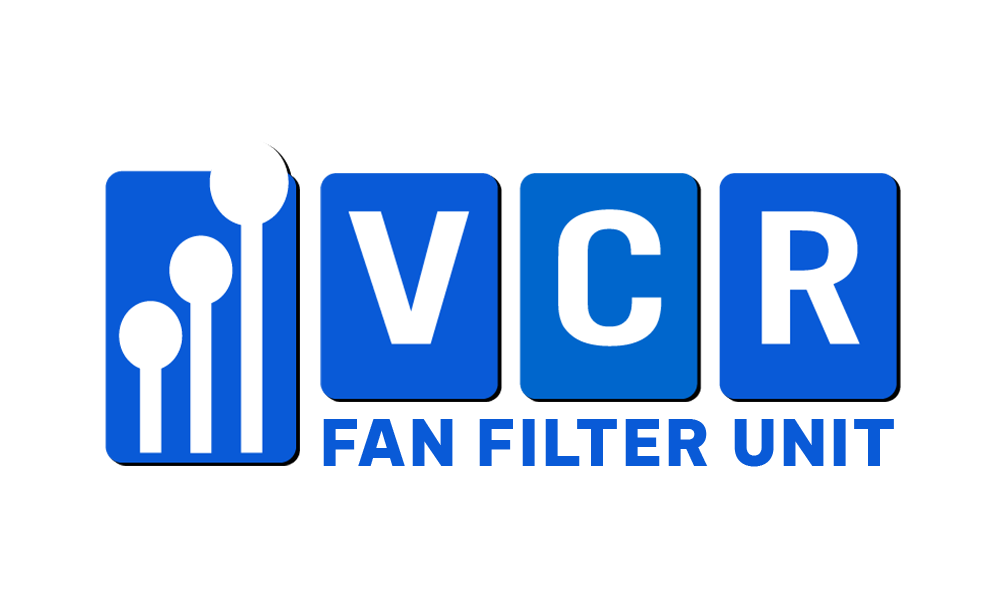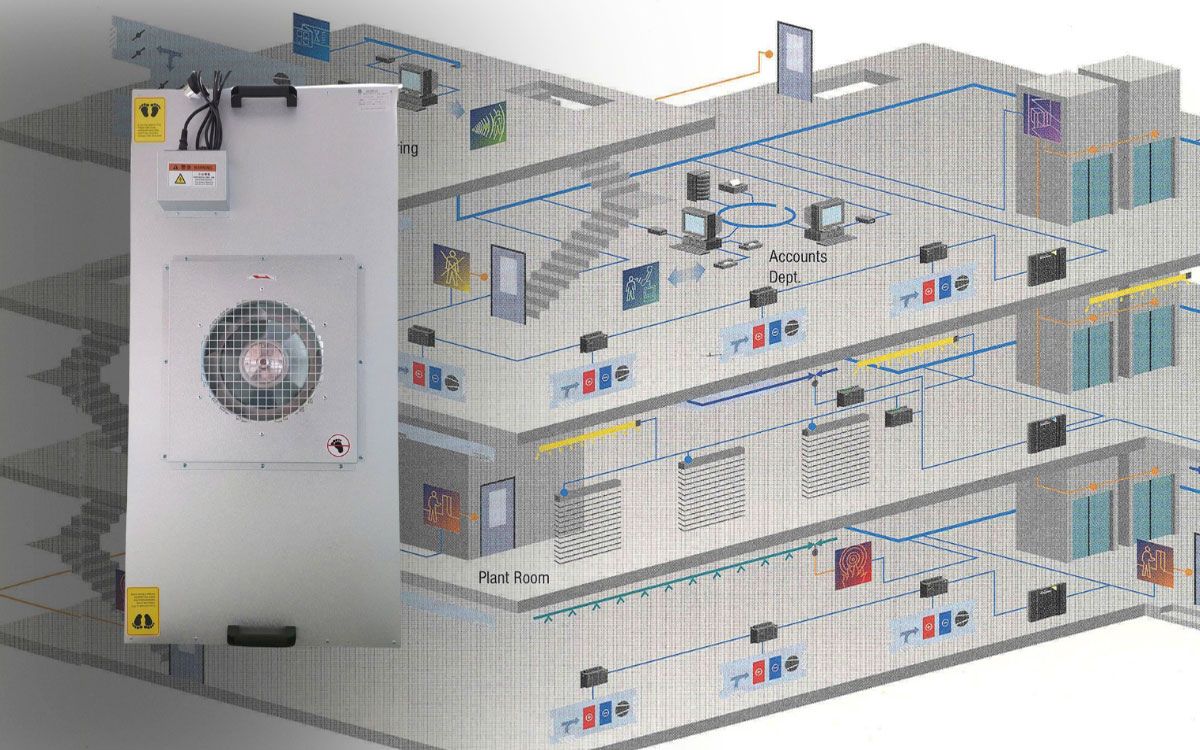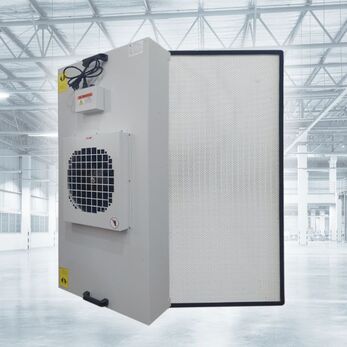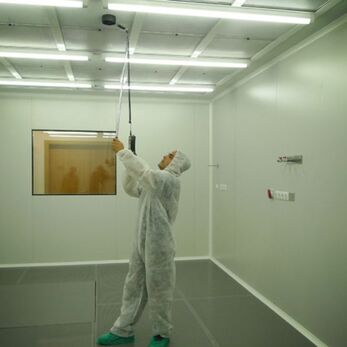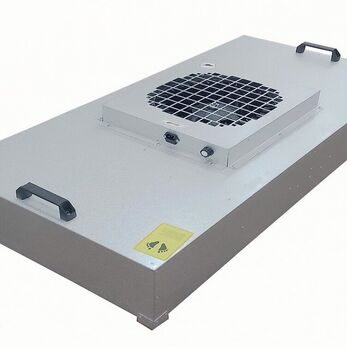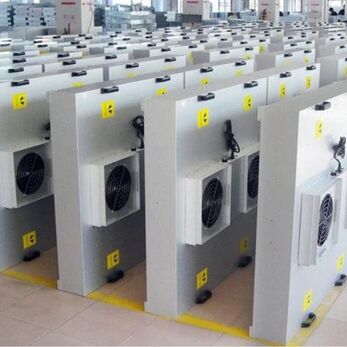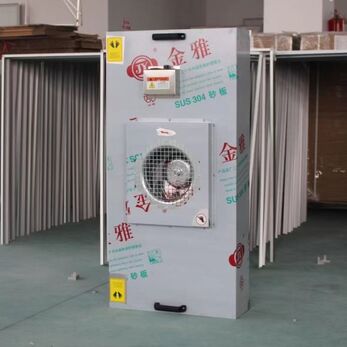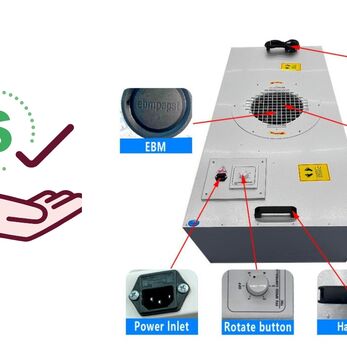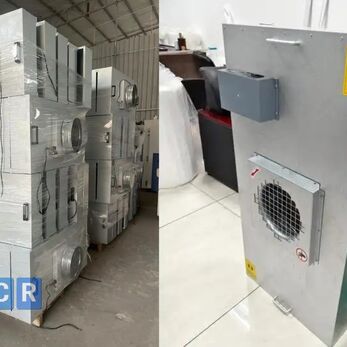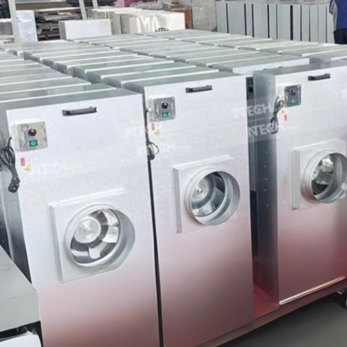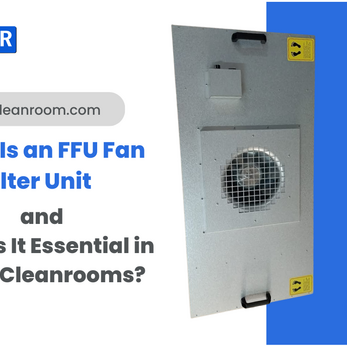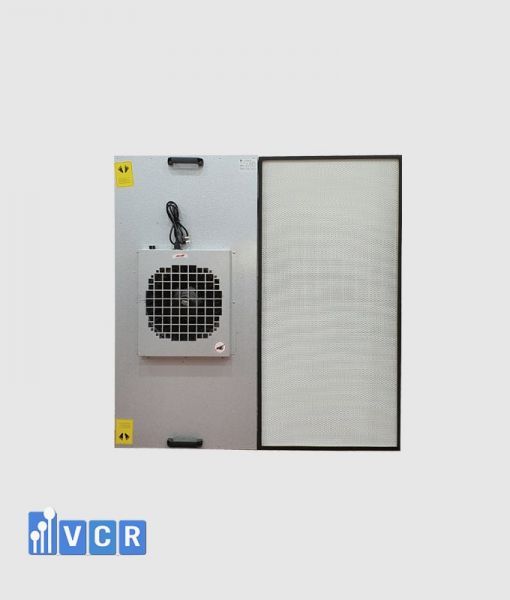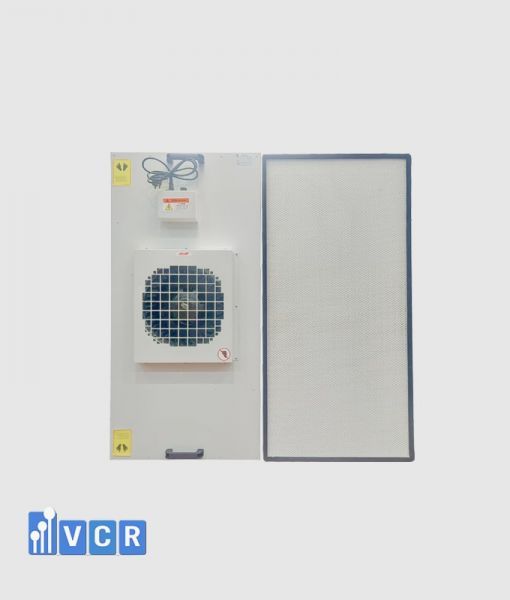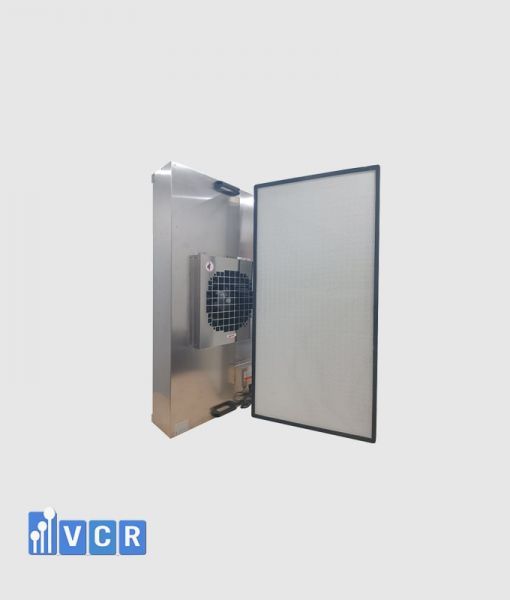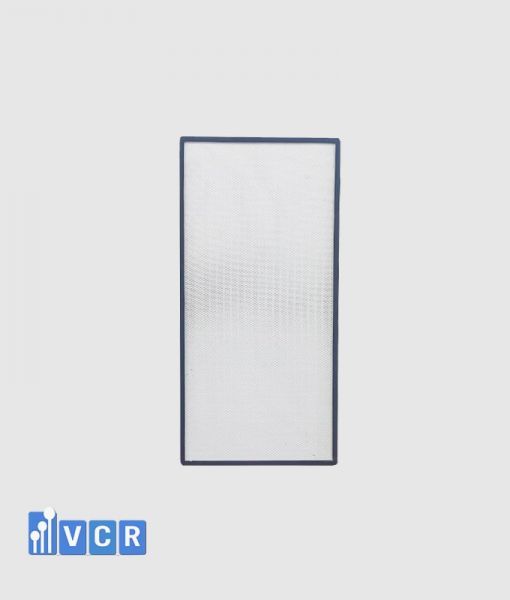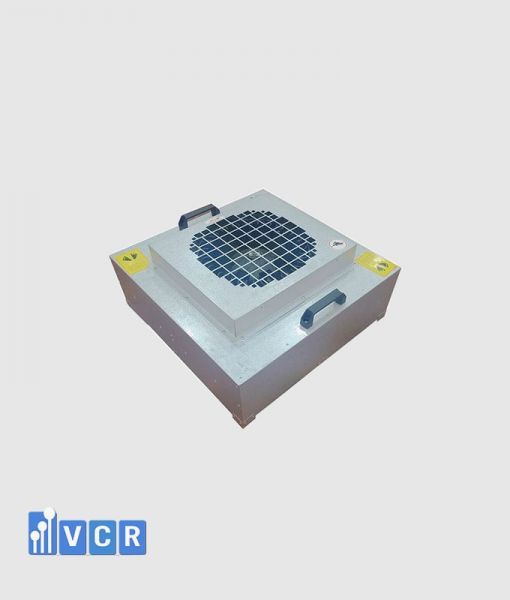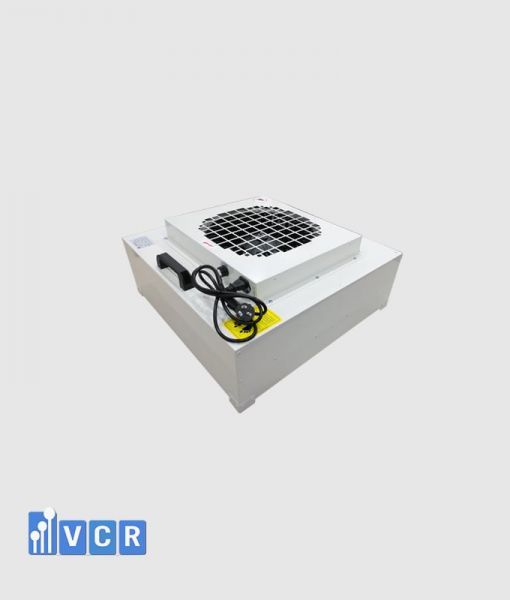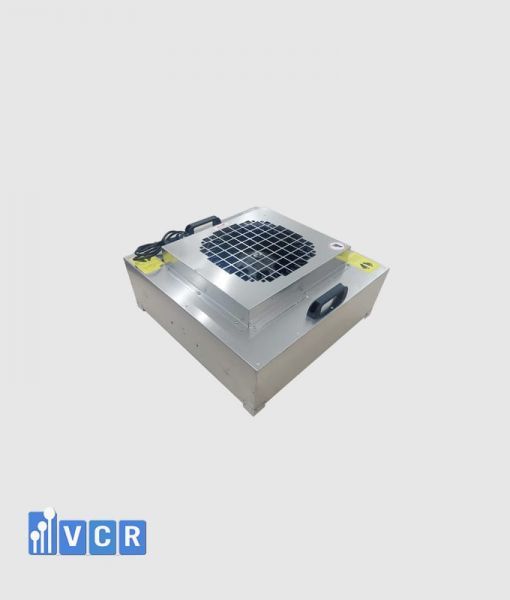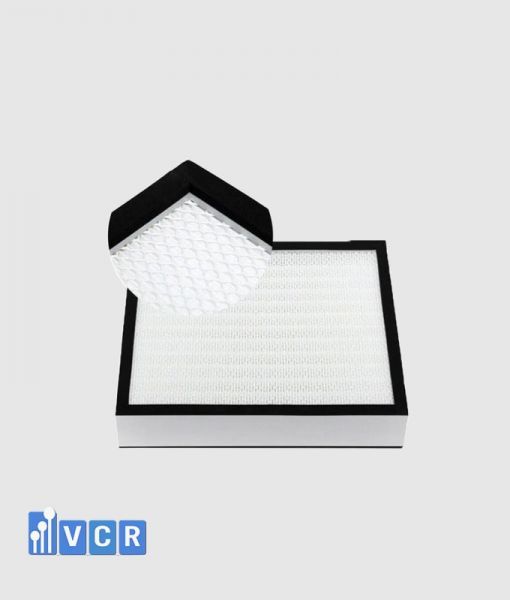FFU plays an important role in maintaining a stable clean environment for clean rooms. For optimal efficiency, calculating the correct FFU airflow according to the room area is a key factor, helping to ensure the desired level of cleanliness while still saving energy.
- 1. What is an FFU and its role in cleanrooms?
- 2. What is FFU airflow rate and why should it be calculated based on room size?
- 3. Formula for calculating required airflow based on room area
- 4. How to determine the appropriate number of FFUs
- 5. Factors affecting FFU airflow performance
- 6. Considerations When Choosing FFUs for Different Industries
- 7. Frequently Asked Questions about FFUs and Cleanroom Airflow
- 8. Need Help Calculating the Number of FFUs for Your Cleanroom?
1. What is an FFU and its role in cleanrooms?
What is an FFU (Fan Filter Unit)?
An FFU (Fan Filter Unit) is a device that integrates a fan and a HEPA or ULPA filter into a single unit, typically installed on the ceiling of a cleanroom. The FFU draws air from above, filters out ultrafine dust particles, and then blows clean air downward in a laminar flow.
The key advantage of an FFU is that it operates independently, without relying on a central HVAC system. It is a modular air filtration solution that allows users to flexibly determine the number of units based on the room’s size and required cleanliness level.
FFU applications across ISO 5 to ISO 8 cleanroom levels
FFUs are widely used in cleanrooms ranging from ISO Class 5 to ISO Class 8, thanks to their ability to deliver high and stable airflow. Some common applications include:
|
Industry |
Cleanroom Level |
FFU Installation Areas |
|
Electronics - Semiconductors |
ISO 5 - ISO 6 |
SMT ceilings, clean booths |
|
Pharmaceuticals - Cosmetics |
ISO 7 - ISO 8 |
Packaging rooms, filling rooms |
|
Food Processing |
ISO 7 - ISO 8 |
Pre-processing and packaging areas |
With flexible modular installation, FFUs help designers achieve the required air changes per hour (ACH) without relying entirely on central HVAC systems.
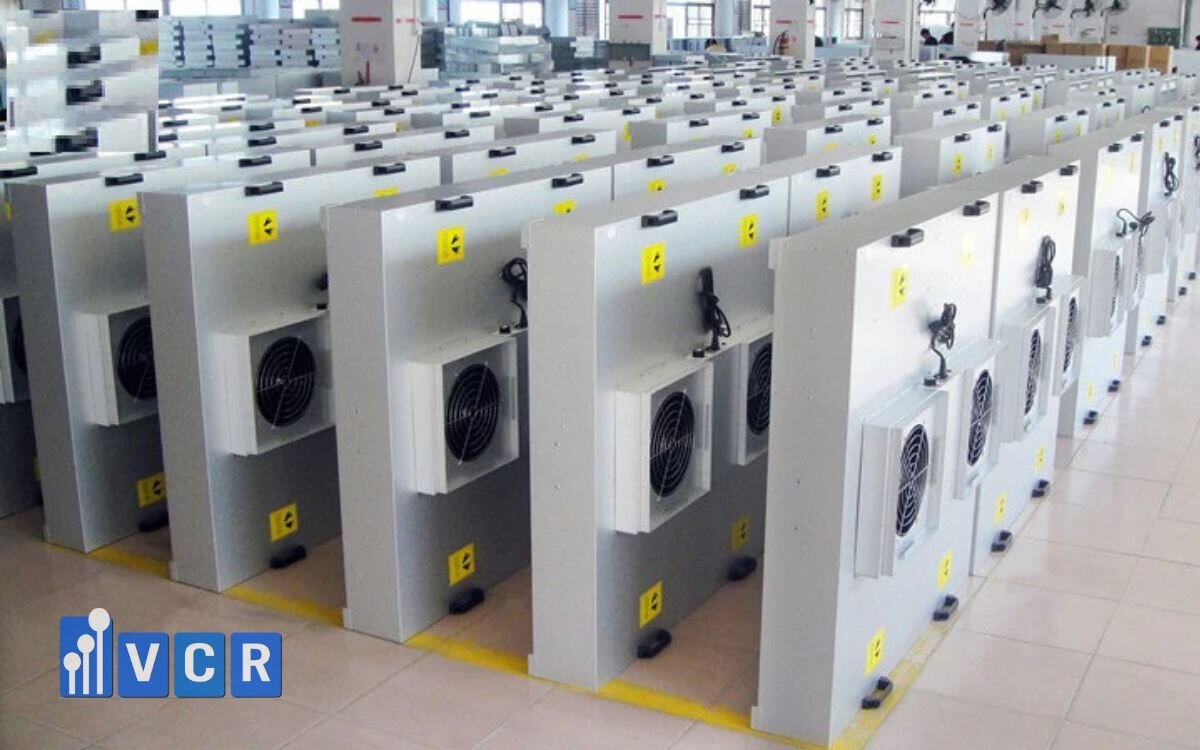
Comparison: FFU vs. HEPA Box vs. AHU Systems
|
Criteria |
FFU |
HEPA Box |
AHU + Duct System |
|
Operating Mechanism |
Built-in fan pushing air through filter |
Air from AHU through HEPA filter |
Centralized air handling unit system |
|
Airflow Capacity |
Modular, flexible |
Depends on AHU |
Large, fixed volume |
|
Installation & Expansion |
Easy |
Moderate |
Complex |
|
Maintenance & Replacement |
Per unit |
Requires AHU shutdown |
System-wide dependency |
|
Suitable for Cleanroom |
ISO 5-8 |
ISO 6-8 |
ISO 8+ or pre-filtration zones |
Conclusion: If you're designing a small cleanroom or upgrading to a higher ISO level, FFUs are a more flexible and efficient choice than HEPA Boxes or traditional AHUs.
See more: Latest price list of FFU Fan Filter Unit used in medical clean rooms
2. What is FFU airflow rate and why should it be calculated based on room size?
What is airflow rate? (CFM / m³/h)
Airflow rate refers to the volume of air that flows through a device in a specific period. Common units include:
- CFM (Cubic Feet per Minute)
- m³/h (Cubic meters per hour) - commonly used in Vietnam and Europe
For example: An FFU with a 1000 m³/h rating can deliver 1000 cubic meters of clean air per hour into the room.
Why is airflow rate important in cleanrooms?
Cleanrooms require strict control of airborne particles. To maintain cleanliness levels as per ISO standards, the air must be continuously refreshed to remove contaminants from personnel, equipment, and materials.
If airflow is too low:
- Dust is not removed promptly → ISO level may be violated
- Higher risk of cross-contamination, especially in pharma/cosmetics
If airflow is too high:
- Energy waste, increased operational costs
- May impact pressure balance and temperature stability
Thus, calculating airflow based on actual room size and application is essential during design or renovation.
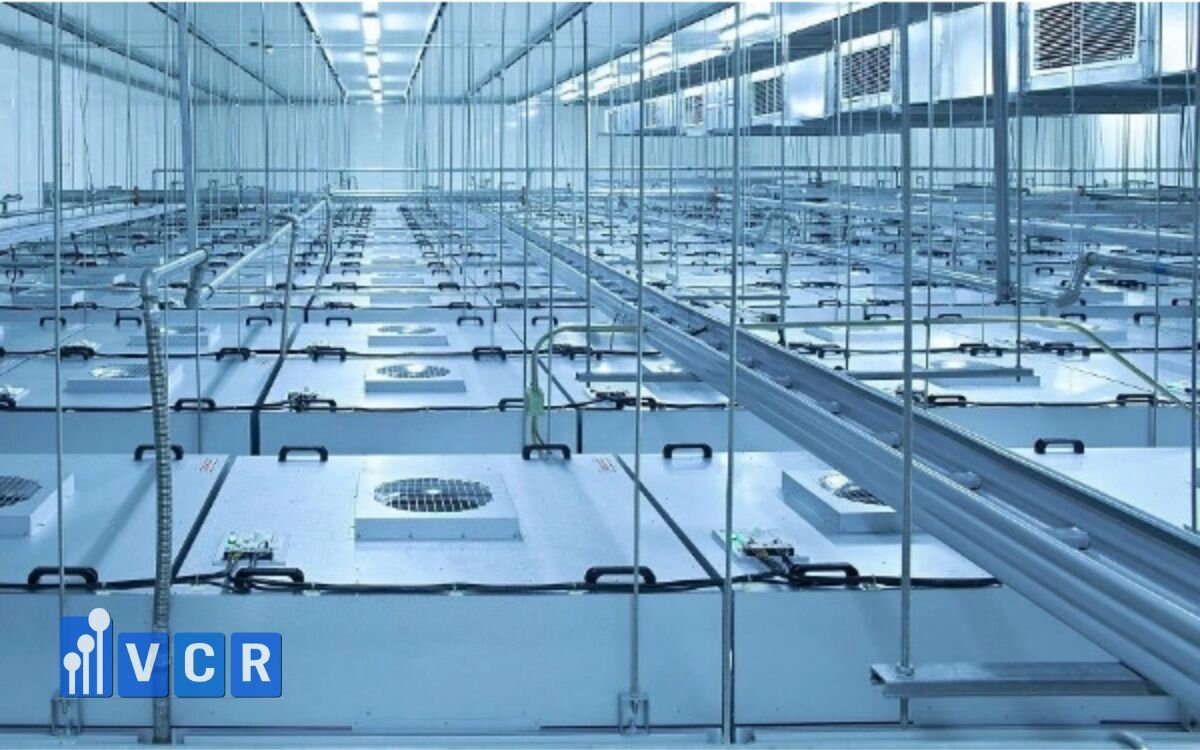
ISO 14644 air changes per hour (ACH) requirements
ACH (Air Changes per Hour) indicates how many times the air in a room is replaced every hour.
|
ISO Class |
Air Changes per Hour (ACH) |
Common Application Areas |
|
ISO Class 5 |
240 - 480 |
Airlocks, sterile filling areas |
|
ISO Class 6 |
150 - 240 |
Weighing rooms, pharma packaging |
|
ISO Class 7 |
60 - 150 |
Food and cosmetic manufacturing |
|
ISO Class 8 |
20 - 60 |
Storage areas, gowning rooms |
For example, an ISO 7 room may require at least 60 ACH, meaning all air in the room must be replaced 60 times per hour to maintain particle concentration below ISO limits.
See more: Unveiling the Advantages of FFU Systems in Cleanrooms
3. Formula for calculating required airflow based on room area
Basic airflow calculation formula
To determine the total airflow required for a cleanroom, use the following formula:
Airflow (m³/h) = Room Area (m²) × Ceiling Height (m) × Air Changes per Hour (ACH)
Where:
- Room area = length × width
- Ceiling height = typically 2.4 - 3.0 meters
- ACH = based on required ISO level
Reference ACH by ISO cleanroom class
|
ISO Class |
Recommended ACH |
Common Usage |
|
ISO Class 5 |
240 - 480 |
Buffer zones, aseptic filling |
|
ISO Class 6 |
150 - 240 |
Weighing, pharma packaging |
|
ISO Class 7 |
60 - 150 |
Food and cosmetic production areas |
|
ISO Class 8 |
20 - 60 |
Gowning rooms, raw material storage |
Note: These values are for reference. Actual ACH may vary depending on industry requirements and room design.
Practical example: 20m² room, 2.5m high, ISO 7 requirement
Assuming 80 ACH is required:
- Room area = 20 m²
- Ceiling height = 2.5 m
- ACH = 80
Airflow = 20 × 2.5 × 80 = 4,000 m³/h
Therefore, to maintain ISO 7 standards, this 20m² cleanroom must receive 4,000 m³/h of clean air per hour.
In the next section, we will calculate how many FFUs are needed to meet this airflow requirement.
4. How to determine the appropriate number of FFUs
Standard airflow of each FFU
Typically, each FFU can provide an airflow ranging from 800 to 1200 m³/h, depending on:
- Size (e.g., 600×600mm, 1200×600mm)
- Fan type (AC or EC)
- Filter resistance (HEPA or ULPA)
Note: For design purposes, it's recommended to use an average value of 1,000 m³/h per FFU unless exact specifications of the selected model are known.
How to calculate the required number of FFUs
Once you’ve calculated the total required airflow, you can use the following formula:
Number of FFUs = Total airflow (m³/h) ÷ Airflow per FFU
Example:
For a cleanroom of 20 m² with a ceiling height of 2.5 m, targeting ISO 7:
- Required airflow = 4,000 m³/h
- FFU airflow = 1,000 m³/h
➡ Number of FFUs = 4,000 ÷ 1,000 = 4 FFUs
Recommended FFU layout based on ceiling configuration
Depending on airflow objectives and room shape, the FFUs can be arranged in the following ways:
|
Layout Type |
Description |
Suitable For |
|
Corner layout |
Install FFUs at room corners to create circular airflow |
Small rooms, low ceilings |
|
Centralized layout |
Install FFUs directly above workstations |
Production rooms with fixed work zones |
|
Even distribution |
Spread FFUs evenly across the ceiling for uniform airflow |
High ISO rooms (ISO 5-6), large areas |
Note: Combine with air return grilles, differential pressure gauges, and cleanroom lights to optimize airflow performance and illumination.
See more: Laminar Airflow Cleanroom Control in FFUs
5. Factors affecting FFU airflow performance
Although FFUs have a rated airflow capacity, actual performance may vary due to multiple influencing factors. Understanding these factors ensures accurate calculations and stable cleanroom performance.
Cleanroom ceiling height
Higher ceilings mean larger room volumes, which require higher airflow to maintain the same ACH (air changes per hour).
Rooms with the same floor area but different heights (e.g., 2.4 m vs. 3.0 m) will need a different number of FFUs.
Tip: Always determine the ceiling height early in the design phase to avoid underestimating FFU quantity.
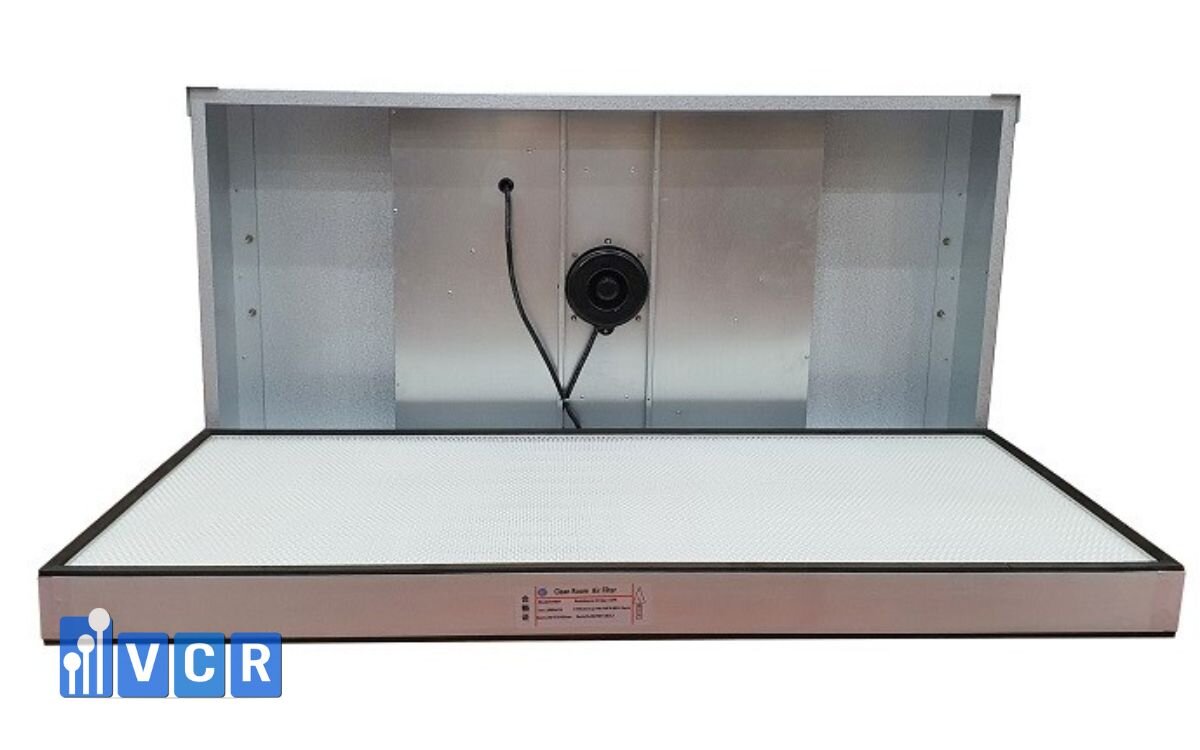
Resistance of HEPA/ULPA filters
HEPA filters typically start with low resistance but increase over time due to particle buildup.
- Increased resistance → Reduced airflow → Inadequate air exchange → Cleanroom standard violations
Solutions:
- Use EC fan FFUs that automatically adjust pressure
- Monitor pressure drop using a differential pressure gauge
- Schedule filter replacements based on manufacturer guidelines
Airflow design: unidirectional, recirculated, or hybrid
- Unidirectional flow (laminar): Requires high airflow and dense FFU layout
- Recirculated via AHU or return fans: Reduces FFU supply airflow demand
- Hybrid systems: Offer flexibility but may lead to uneven airflow if poorly designed
If FFUs are used in a recirculated setup, account for return airflow to avoid turbulent zones that trap particles.
Application-specific requirements
Each industry has unique operating standards, directly affecting airflow demand:
|
Industry |
Specific Requirements |
Impact on Airflow |
|
Pharmaceuticals |
GMP requires cross-contamination control and pressure differentials |
Requires high, stable airflow |
|
Electronics - SMT |
Static control, ultrafine particle filtration |
Requires high-quality, consistent-speed FFUs |
|
Food Industry |
Microbial, odor, and humidity control |
Prioritizes rapid air exchange and high airflow |
Note: Select FFUs specialized for your industry and consider additional requirements such as pressure control, ESD protection, and noise levels.
6. Considerations When Choosing FFUs for Different Industries
Selecting an FFU is not solely based on airflow; it must also consider the operational characteristics and technical standards specific to each industry. Below are key considerations to help you choose the right unit that meets standards and ensures long-term performance.
FFUs for the Pharmaceutical Industry (GMP, EU-GMP, WHO-GMP)
Special requirements:
- Strict control of airborne particles and microorganisms
- Many zones require positive pressure and stable airflow
- Cross-contamination is likely if airflow patterns are incorrect
Recommended FFU specifications:
- EC fans capable of maintaining consistent airflow over time
- Low noise level: suitable for packaging and filling rooms
- HEPA filters rated H14 or higher, with individual test certification (scan test)
- Integrated pressure gauges or pressure test ports
Best used in: weighing rooms, aseptic filling areas, airlocks
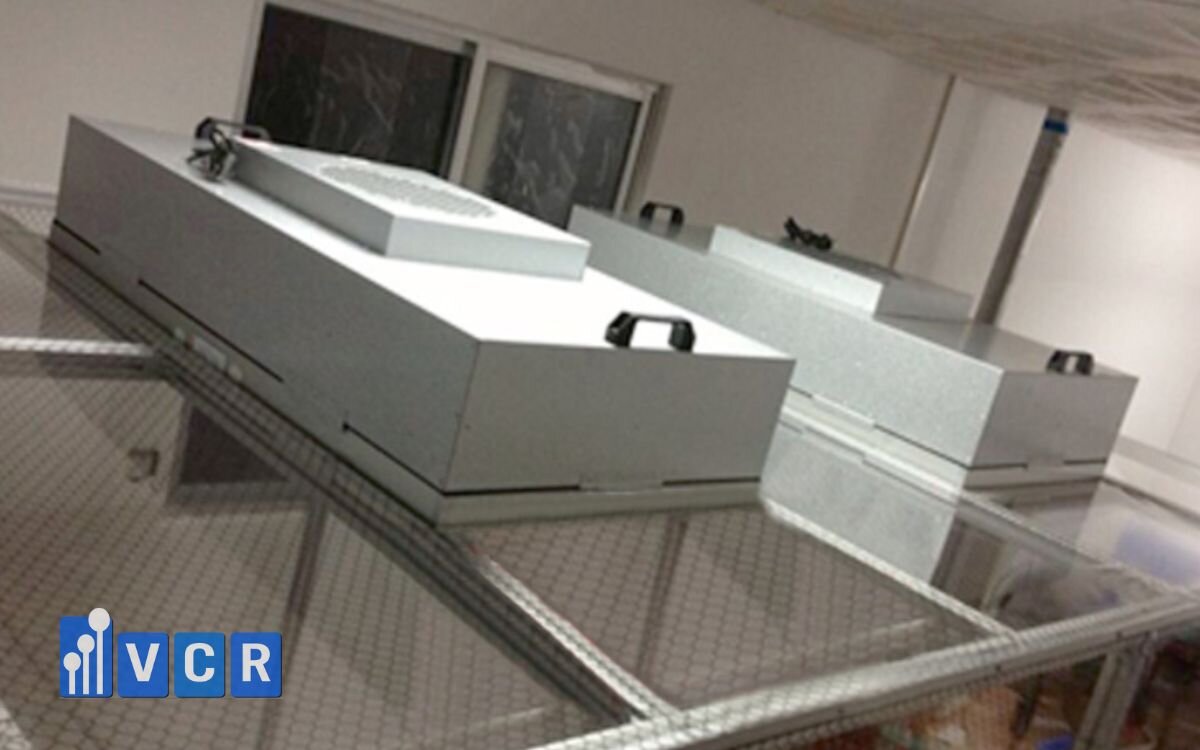
FFUs for the Food Industry
Special requirements:
- Environments with odors, humidity, and vapors
- Rapid air exchange needed to prevent microbial growth
- Some production areas contain oil, grease, or light dust
Recommended FFU specifications:
- High airflow (above 1000 m³/h) for fast air changes
- Option to integrate odor removal filters (carbon filter) before the HEPA
- Easy-to-clean casing (powder-coated or stainless steel)
- Sealed motor to resist moisture
Best used in: dry food packaging, seasoning production, pre-processing zones
FFUs for Electronics, Semiconductors, SMT
Special requirements:
- Sub-micron particle control
- Electrostatic discharge (ESD) is a major risk for components
- Requires uniform, turbulence-free airflow
Recommended FFU specifications:
- EC fans with smooth operation and precise speed control
- Anti-static casing, DC motor fans that don’t generate sparks
- Optional built-in ionizers to neutralize static charge
- Minimal airflow fluctuation (±5%)
Best used in: SMT cleanrooms, PCB testing labs, chip printing rooms
See more: FFU Control Modes in Industrial Cleanrooms
7. Frequently Asked Questions about FFUs and Cleanroom Airflow
1. How much air can one FFU deliver per hour?
Typically, an FFU can deliver between 800 and 1200 m³/h depending on its model, size, and fan type (AC or EC). A standard value of 1,000 m³/h is often used for design calculations.
2. How many FFUs are needed for a 30 m² cleanroom with a 2.5 m ceiling, ISO 7?
Using the formula:
Airflow = Area × Height × ACH
= 30 × 2.5 × 80 = 6,000 m³/h
If each FFU provides 1,000 m³/h → 6 FFUs are required.
3. Are FFUs mandatory in all cleanrooms?
No. FFUs are not mandatory in every cleanroom. However, they are an ideal solution for small cleanrooms, ISO level upgrades, or areas requiring independent and stable airflow without the need for complex HVAC systems. For large spaces, AHUs combined with HEPA Boxes may be more cost-effective.
4. How can I tell if an FFU is underperforming?
Common signs include:
- Weak airflow despite fan operation
- Unusual increase in HEPA filter pressure drop
- Elevated particle counts during ISO tests
Installing a differential pressure gauge and conducting periodic inspections are recommended based on manufacturer guidelines.
5. Are FFUs noisy?
High-quality FFUs using EC fans typically produce low noise levels (~45-50 dB). However, using cheaper models, AC fans, or incorrect installation may result in noise that affects the working environment.
8. Need Help Calculating the Number of FFUs for Your Cleanroom?
Choosing and positioning FFUs isn’t just about “buying the right quantity.” Each industry, cleanroom, and ISO level has unique requirements for airflow, pressure, flow direction, and energy efficiency.
Avoid costly design mistakes and compliance issues with GMP or ISO standards.
Contact the VCR technical team for:
- Free consultation on FFU sizing tailored to your industry
- Supply of certified, genuine FFUs
- Support in designing the most effective FFU layout for your space
Hotline: 090.123.9008
Email: [email protected]
Website: https://ffu.com.vn/
Diep VCR


